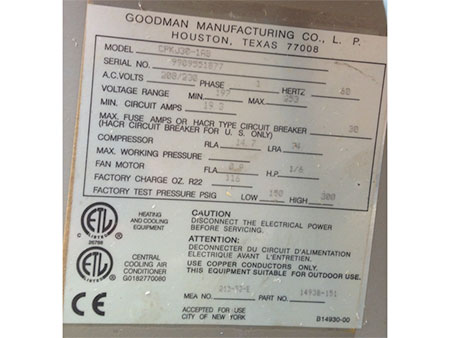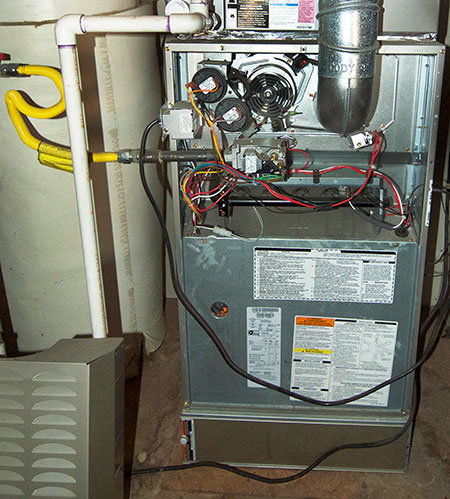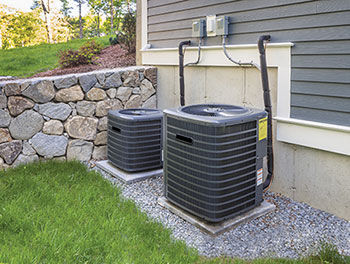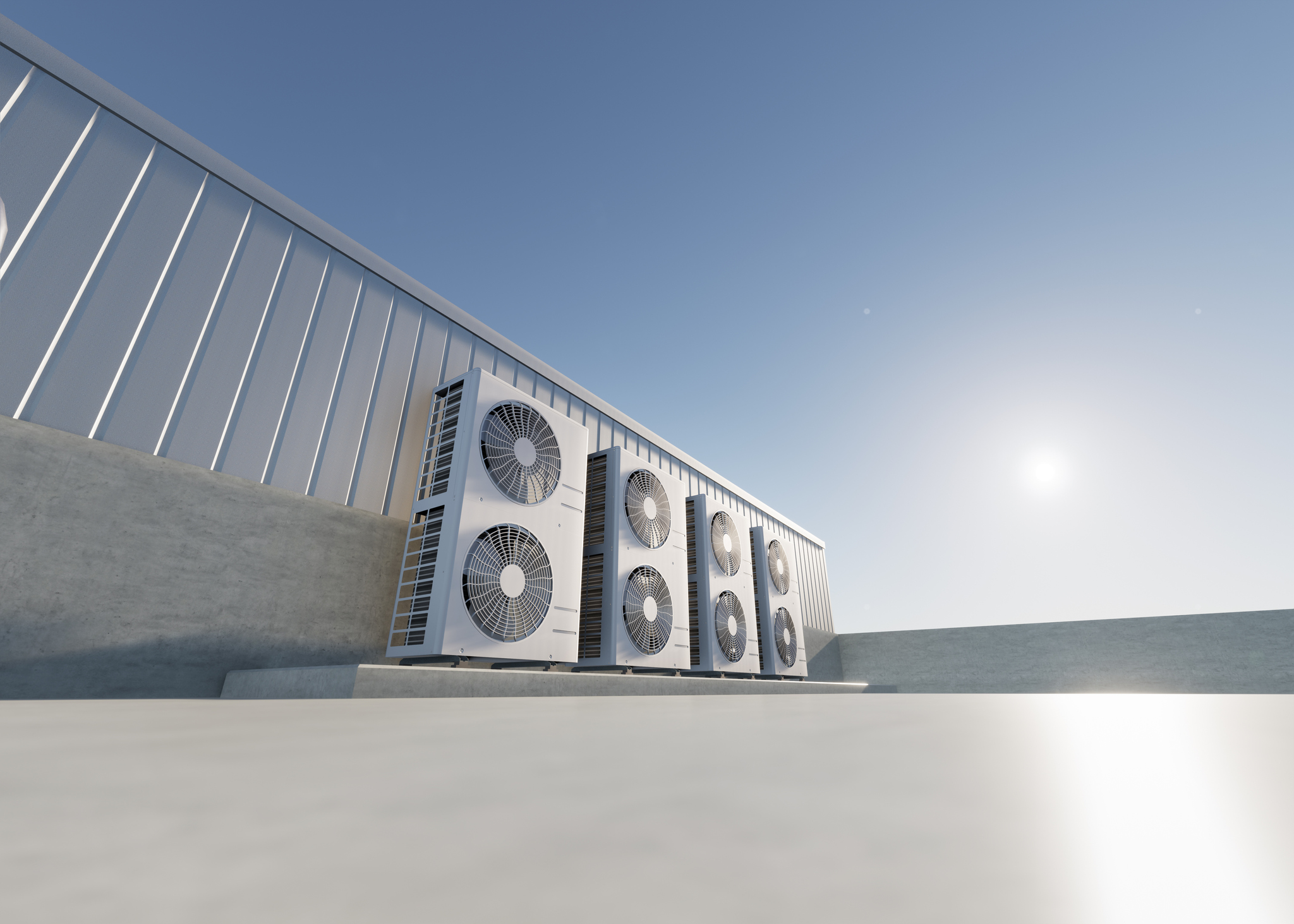For many reasons, the most important day in the life of heating, ventilating, and air-conditioning (HVAC) equipment is the day it is installed. The selection and installation of HVAC equipment is surrounded with parameters that must be considered which go beyond the heating and cooling details to the important stuff— the electrical supply and all associated details. It’s not unlikely that the designer spent more time focusing on sizing the system as well as all of the controls and efficiencies, and less attention on the details associated with the electrical installation.
The system must perform to the expectations of the design and do so for a long time without experiencing issues outside of normal maintenance concerns. The use of listed products for not only the HVAC equipment itself but all of those components help the system perform safely. It is important that the equipment is installed per their listing requirements/manufacturer instructions. The designer, installer and inspector can be presented with a challenge when trying to determine the proper size of overcurrent protective devices and/or proper short-circuit current ratings for this equipment and more, which may have been overlooked, because the focus for the success of the system is focused elsewhere.

The devil is in the details, so they say, and these details are important to the proper long-lasting performance of the equipment. It’s better to find the problems early rather than late in the process to reduce costs and delays in the project. Both the installer and the inspector must deal with those details.
HVAC systems are a very important aspect of a structure or the specific area/service it provides. These systems must perform to provide comfortable and safe environments in some cases, or warm/cold water or similar in others. HVAC systems demand a considerable amount of energy and add a significant load to the electrical system. These systems account for 39% of the energy used in commercial buildings in the United States demanding attention for not only new system designs but for existing designs as well. Any business or government agency can potentially realize significant savings by improving HVAC operations and efficiencies; so as installers and inspectors, working with this equipment should not be a once in a lifetime event. Building owners abroad seek to find those savings that can be realized when attention is given to selection, design and installation of high performance HVAC equipment. This investment made by the owner must operate as designed; proper installation is important to its success.
Proper installation and inspection of HVAC equipment is not a trivial task; and given the complexity of this subject, I offer this article as a starting point as you embark on reviewing and/or installing HVAC equipment.
Types of Systems
I’ll go out on a limb and say that HVAC systems can be classified into four categories: heating only, ventilating only, cooling only, or air-conditioning systems. I’m going to climb further out on that limb and divide each of these into local or central types of systems.
Local HVAC systems are localized to the area or zone for which they serve. The equipment is either in the zone or on the edge of the zone. Examples of these types of systems include but are not limited to:
Heating Only: Local heating means to heat, for example, a room or water.
- Portable electric heaters
- Built-in electric resistant heaters
- Electric baseboard heaters
Cooling only: Local cooling means to cool, for example, a room or liquid such as water.
- Fountain coolers
- Refrigeration
Ventilating only: Local ventilation means to move air into or out of a space.
- Ventilation fans (paddle, blowers)
Air-Conditioning: A system that heats and cools, for example, a room.
- Window air conditioners; some of which may include heaters to provide both functions of heating and cooling.
- Split systems which include an exterior unit (consisting of compressor and condenser elements) and an interior unit (consisting of evaporator and expansion valve elements)
- Central systems are much more complicated from the perspective of controls and distribution of conditioned air. These systems have more than one thermal zone and include more components that help the system achieve its goals. These systems will find central HVAC equipment that acts to cool, heat, heat and cool and distribute the conditioned air to all of the thermal zones.
No matter what the case, the proper installation of all components of either local or central systems must ensure the equipment functions as intended. Installation per the National Electrical Code and manufacturer’s instructions is important to achieve this goal.
The following are UL standards related to the topic of HVAC.
- UL 250 Household Refrigerators & Freezers
- UL 399 Standard for Drinking-Water Coolers
- UL 471 Standard for Commercial Refrigerators & Freezers
- UL 484 Standard for Room Air Conditioners
- UL 1995 Heating and Cooling Equipment
- UL 60335-2-34 Standard for Household and Similar Electrical Appliances, Part 2: Particular Requirements for Motor-Compressors
- UL 60335-2-40 Safety of Household and Similar Electrical Appliances, Part 40: Particular Requirements for Heat Pumps, Air Conditioners, and Dehumidifiers.
As installers and inspectors, we should understand that UL standards are not documents purchased and read in similar manner to the NEC. UL standards are generated to help a manufacturer test and ensure their products meet third party performance criteria which, in turn, ensure they function as intended and do so safely. The tool UL provides and which works hand-in-hand with the NEC is the white book (www.ul.com/whitebook). This reference is free from their web site and is usually handed out free at various IAEI meetings. This reference contains information and aspects of the equipment that help with the installation and inspection during construction. An important section for this discussion is in Appendix A, “UL Marking Guide.” This appendix includes a marking guide for “Electric Heating and Cooling Equipment.” The marking guides included in this appendix in general are very useful to the installer and inspector as it describes all of the marks required by UL for the equipment. This is the first reference for your library.
Marking Requirements for HVAC Equipment
Nameplates on equipment can be confusing to many and the fact that the information included may vary from manufacturer to manufacturer and even model to model for a specific manufacturer doesn’t make our lives easier. When confronted with diversity such as that which can be found on nameplates, I always run home to the fundamentals. Easier said than done, the fundamentals should be the foundation we use to understand what we are seeing and hearing for that matter.
Our first point of reference as noted above is the UL White book marking guide found in Appendix A of that document. This document helps us understand the complexities involved with HVAC equipment that can make it difficult when determining the load, branch-circuit ampacity, and overcurrent protective device sizing. HVAC equipment can be very simple, those with only one motor load for which the motor nameplate information may be all that is needed to determine necessary electrical circuit requirements. HVAC equipment can be quite complex with voltage ratings that vary. For example voltage ratings can be a single nominal value such as 230 V or ranges expressed as “220–240.” Standard voltage ranges include 110–120, 200–208, 220–240, 254–277, 440–480 and 550–600. A single unit may have more than one voltage rating because more than one supply circuit can be connected. A unit with more than one supply circuit will probably have different load ratings for each circuit. Determining the load ratings may not be as clear as you would think, for some of these will only list one load rating which represents the highest load possible for that piece of equipment.
Per UL 1995, the HVAC nameplate can specify the type of overcurrent protective device that must be used. When the nameplate specifies “Maximum Overcurrent Protective Device,” then either a circuit breaker or fuse is permitted. If the nameplate is marked “Maximum Fuse_____,” then fuse protection must be provided in accordance with the label. If the nameplate is marked “Maximum Circuit Breaker_____,” a circuit breaker must be provided in accordance with the label. Sometimes the equipment makes life easy for the installer/inspector.
These variables can make reading a nameplate challenging. The UL Marking guide can help interpret what you are seeing. As always there is the call to the manufacturer that should be made if needed. The important thing to remember is that the installation should meet the listing requirements as well as NEC requirements.

NEC Requirements
HVAC equipment must get power from some electrical source and how that occurs is directly impacted by the National Electrical Code. Circuit ampacity, wire size, branch-circuit short-circuit and ground-fault protection requirements are just examples of the details necessary to supply this equipment that are included in the NEC. The following are some key articles important to the successful application of HVAC equipment.
Of the articles that apply generally, the following are important:
- Article 110, Requirements for Electrical Installations
- Article 210, Branch Circuits
- Article 220, Branch-Circuit, Feeder, and Service Calculations
- Article 240, Overcurrent Protection
- Article 422, Appliances
- Article 424, Fixed Electric Space-Heating Equipment
- Article 426, Fixed Outdoor Electric Deicing and Snow-Melting Equipment
- Article 427, Fixed Electric Heating Equipment for Pipelines and Vessels
- Article 430, Motors, Motor Circuits, and Controllers
- Article 440, Air Conditioning and Refrigerating Equipment
The following are those special locations and specific applications that may impact your HVAC installation:
- Article 502, Class II Locations
- Article 517, Health Care Facilities
- Article 550, Mobile Homes, Manufactured Homes, and Mobile Home Parks
- Article 552, Park Trailers
- Article 620, Elevators, Dumbwaiters, Escalators, Moving Walks, Platform & Stairway Chairlifts
- Article 645, Information Technology Equipment
- Article 646, Modular Data Centers
- Article 665, Induction and Dielectric Heating Equipment
- Article 670, Industrial Machinery
- Article 680, Swimming Pools, Fountains, and Similar Installations
As you can see, there are many sections of the NEC that will impact the HVAC system being installed. The challenge to the installer and inspector is to ensure all of the applicable code requirements are met. The following are some general guidelines to help in the application of HVAC equipment.
Branch Circuit Protection HVAC
Let’s review requirements for Individual Motor-Compressor(s) and HVAC Equipment Having Motor-Compressor(s) and Other Loads (Such as fan motors, electric heaters, coils, etc.).
NEC Section 440.22(A) for individual motor-compressor applications tells us that the overcurrent protective device (OCPD) sized for branch-circuit protection only must not exceed 175% of the hermetic motor-compressor rated load current or branch circuit selection current (whichever is larger). If this size OCPD cannot withstand the motor starting current, a higher amp rating is permitted, but in no case can the OCPD size exceed 225%.
Always refer to the nameplate on the equipment as the sizing (amp rating) for overcurrent protection may have been determined by the manufacturer of the equipment. Should that be the case, it is not necessary to apply any further multipliers to arrive at the proper size. The marked protective device rating is the maximum protective device rating for which the equipment has been investigated and found acceptable by nationally recognized testing laboratories. When the nameplate states the maximum size fuse or circuit breaker, it is critical that this direction must be followed without exception to be in compliance with 110.3(B) of the NEC. Remember, NEC® 110.3(B) requires that listed or labeled equipment must be installed in accordance with any instructions included in the listing or labeling.
Disconnecting Means (Individual hermetic motor compressor)
NEC Section 440.12(A)(1) for hermetic refrigerant motor-compressors tells us that the amp rating of the disconnect shall be at least 115% of the compressor’s rated load current or branch-circuit selection current, whichever is greater. The Exception to Section 440.12(A)(1) permits a non-fused disconnect rated less than 115% of the specified current if this disconnect has a horsepower rating not less than the equivalent horsepower rating per 440.12(A)(2).
The equivalent horsepower rating to comply with Section 430.109 can be obtained by taking the larger horsepower value from:
(1) NEC® Tables 430.248, 430.249 or 430.250 using the greater of either the rated-load current or the branch-circuit selection current to select the corresponding horsepower rating,
or
(2) horsepower rating from Tables 430.251(A) and 430.251(B) corresponding to the locked-rotor current.
For both preceding (1) and (2) and as per Section 440.12(A)(2), if the value falls between two horsepower ratings in a table, the equivalent horsepower rating to use is the larger of the two; i.e., round up to the larger Hp.
Disconnecting Means (Equipment that has hermetic motor-compressor and other loads)
NEC Section 440.12(B)(2) tells us that the amp rating of the disconnecting means must be at least 115% of the sum of all of the individual loads within the equipment at rated load conditions. The exception to Section 440.12(B)(2) permits a non-fused disconnect rated less than 115% of the sum of all the individual loads if the disconnect has a horsepower rating not less than the equivalent horsepower rating per 440.12(B)(1).
The horsepower rating of the disconnecting means must be at least equal to the equivalent horsepower determined per 440.12(B)(1) which accounts for all the individual loads with the equipment at rated load conditions.
Controller
The controller for a hermetic motor-compressor must have a continuous-duty full-load current rating not less than the nameplate rated current or branch-circuit selection current (whichever is larger) (440.41) and the controller must also have a locked-rotor current rating equal to or greater than the locked-rotor current of the compressor [440.41(A)]. Where the controller serves a hermetic motor-compressor(s) plus other loads, the controller rating is determined according to 440.12(B), in much the same manner as determining the disconnecting means rating. It may be necessary to refer to Tables 430.251(A) and (B) to convert locked-rotor current values to horsepower.
The branch circuit protective device rating shall not exceed the maximum protective device rating shown on a manufacturer’s heater table for use with a given motor controller [440.22(C)]. Where the equipment is marked Maximum Size Fuse amp rating rather than stating Maximum Overcurrent Device amp rating, only fuses can be used for the branch-circuit protection.
Marked Short-Circuit Current Rating— New Air Conditioning and Refrigeration Equipment with Multimotor and Combination-Loads
NEC Section 440.4(B) requires the nameplate of this equipment to be marked with its short-circuit current rating. There are exceptions for which this requirement does not apply to this equipment:
- One- and two-family dwellings
- Cord-and-attachment-plug-connected equipment
- Or equipment on a 60A or less branch circuit
So for most commercial and industrial applications, air-conditioning and refrigeration equipment with multi-motor and combination loads must have the short-circuit current rating marked on the nameplate. This facilitates the inspection and approval process. Inspectors need this information to ensure that NEC® 110.10 is met. A potential hazard exists where the available short-circuit current exceeds the short-circuit current rating.
HVAC equipment installed in locations where the available fault current exceeds the listed short-circuit current levels could present a real hazard to property as well as personnel. The short-circuit current rating of the HVAC unit, which is on the nameplate, shall be equal to or greater than the available short-circuit current at the terminals of the HVAC unit. If the HVAC unit nameplate specifies a specific type and size overcurrent protective device (not supplied integral with the unit), then that specific size (as a maximum) and type overcurrent protective device shall be in the building distribution system that supplies the unit.
Room Air Conditioners
Room air conditioners (hermetic refrigerant motor-compressor) installed in the conditioned room are considered as single-motor units when the conditions of 440.62 are met. This condition also applies to conditioners containing a heating unit. Branch circuit requirements are determined by nameplate rating (440.62).
Because of all the fires caused by mistreated cords, single-phase cord-and-plug connected room air conditioners are now required to have either an AFCI (arc-fault circuit interrupter) or a LCDI (leakage current detection and interruption) attached to the plug.
Closing Remarks
The installation and inspection of HVAC equipment may not be as simple as some other aspects of the electrical distribution system. Care should be taken when selecting, installing and inspecting this equipment as the devil is in the details.
As always, keep safety at the top of your list and ensure you and those around you live to see another day.















Find Us on Socials